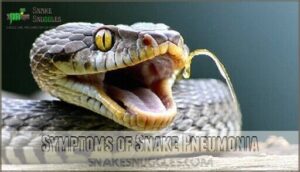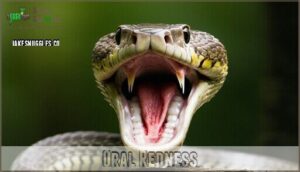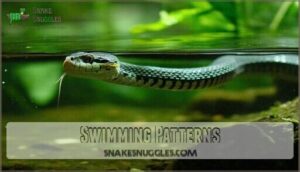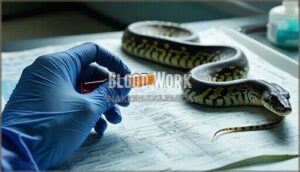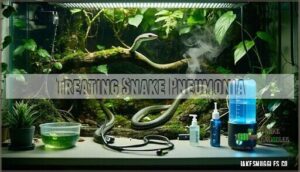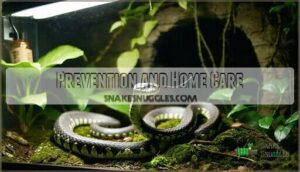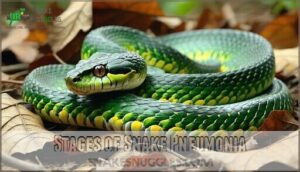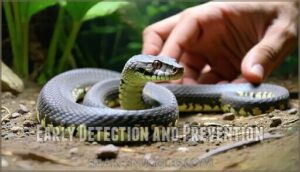This site is supported by our readers. We may earn a commission, at no cost to you, if you purchase through links.
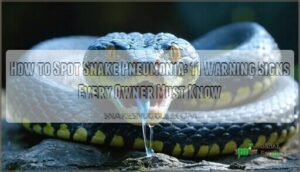
Look for behavioral changes too – your snake might hold its head elevated, stretch out more than usual, or seem restless.
Blue-tinged gums signal serious trouble. Don’t ignore frequent yawning or labored breathing patterns.
These respiratory symptoms can escalate quickly from mild to life-threatening if left untreated. Think of it as your snake’s SOS signal – their body’s crying out for help before things get worse, which is a clear respiratory issue that requires immediate attention to prevent it from becoming life-threatening.
Table Of Contents
- Key Takeaways
- How to Spot Snake Pneumonia?
- Symptoms of Snake Pneumonia
- Recognizing Respiratory Issues
- Causes and Risk Factors
- Diagnosing Snake Pneumonia
- Treating Snake Pneumonia
- Prevention and Home Care
- Stages of Snake Pneumonia
- Diagnosis of Snake Pneumonia
- Progression and Treatment
- Early Detection and Prevention
- Frequently Asked Questions (FAQs)
- How do you know if a snake has pneumonia?
- Can snake mites cause pneumonia?
- How do I know if my snake has a respiratory infection?
- How do you know if a snake is sick?
- Do snakes have respiratory infections?
- What should I do if my snake has a respiratory infection?
- How do I know if my snake has pneumonia?
- How do you treat pneumonia in snakes?
- What does a respiratory infection look like on a snake?
- How do you spot pneumonia?
- Conclusion
Key Takeaways
- Watch for breathing changes – You’ll hear wheezing or clicking sounds, see your snake breathing through its mouth instead of its nose, and notice mucus discharge from the nostrils or mouth.
- Monitor behavioral shifts – Your snake will hold its head elevated, stretch out more than usual, seem restless, and may refuse food while seeking cooler areas in the enclosure.
- Act fast on serious symptoms – Blue-tinged gums, frequent yawning, and labored breathing patterns signal life-threatening conditions that can escalate from mild to deadly within hours.
- Prevent with proper care – You can avoid most cases by maintaining correct temperature (75-85°F), humidity (50-60%), proper ventilation, and clean enclosure conditions while scheduling regular vet checkups.
How to Spot Snake Pneumonia?
Snake pneumonia detection requires careful observation of key respiratory signs and changes in snake behavior. You’ll notice labored breathing, nasal discharge with yellow or green coloring, and decreased activity levels.
Watch your snake’s breathing closely—early detection of respiratory distress can save their life.
Watch for open-mouth breathing, wheezing sounds, and unusual positioning with the head elevated. Snake breathing problems often coincide with loss of appetite and preference for cooler areas.
Pneumonia causes include poor husbandry, temperature fluctuations, and weakened immunity. Early recognition of snake pneumonia symptoms enables prompt veterinary intervention.
Diagnostic tools like X-rays confirm snake respiratory distress, while treatment options combine antibiotics with supportive care for ideal recovery outcomes.
Symptoms of Snake Pneumonia
You’ll notice snake pneumonia symptoms develop gradually, starting with subtle changes that can easily be missed.
These clinical signs include nasal discharge, increased respiratory effort, and behavioral changes that signal your snake’s breathing system is compromised.
Nasal Discharge
When checking for nasal discharge, you’ll notice clear warning signs of respiratory trouble. Healthy snakes don’t produce visible mucus from their nostrils.
Watch for these discharge characteristics:
- Clear or watery fluid indicating early infection
- Yellow or green coloration suggesting bacterial involvement
- Thick, sticky consistency showing mucus buildup
- Persistent flow rather than occasional drops
- Nasal swelling around nostril openings
- Crusty residue forming around discharge areas
- Increased frequency throughout the day
- Strong odor accompanying colored discharge, which can be a sign of bacterial involvement and indicate a need to check for nasal swelling and crusty residue.
Respiratory Effort
Beyond nasal discharge, you’ll notice significant changes in how your snake breathes when pneumonia strikes.
Watch for an increased respiratory rate – healthy snakes breathe slowly and quietly, but sick ones work harder for each breath.
Labored breathing becomes obvious as your pet struggles with compromised lung function.
Open-mouth breathing is a red flag that demands immediate attention.
Normal snakes keep their mouths closed while breathing, so gaping indicates serious respiratory distress.
Listen carefully for wheezing sounds or clicking noises during breathing – these suggest airway obstruction or fluid buildup in the lungs.
You might see your snake’s sides moving more dramatically than usual as it compensates for breathing difficulties.
This increased effort shows the respiratory system is fighting against infection and inflammation, making every breath a challenge.
Unusual Behavior
Behavioral changes often signal underlying health problems in your snake.
When pneumonia strikes, you’ll notice your pet displaying unusual behaviors that break from their normal routine.
Watch for these key warning signs that indicate respiratory distress:
- Lethargy signs and decreased activity levels throughout the day
- Feeding changes including refusal to eat or loss of appetite
- Social withdrawal with excessive hiding and altered resting postures
Recognizing Respiratory Issues
You’ll notice respiratory problems through specific physical signs that appear before breathing becomes severely compromised.
Watch for oral redness, increased restless movement, and abnormal swimming patterns in aquatic species as early indicators of developing pneumonia.
Oral Redness
When examining your snake’s mouth, oral redness serves as a critical warning sign of respiratory distress.
Red, swollen gums signal danger—your snake’s mouth is crying for help before breathing becomes critical.
Red swelling around the gums signals potential mouth infections that can worsen snake respiratory infection. Jaw inflammation and oral lesions create entry points for bacteria, leading to openmouth breathing episodes.
- Gum disease progression: Healthy pink gums shouldn’t show inflammation or mouth lesions requiring immediate veterinary attention. Recognizing stress and immune suppression is vital in preventing respiratory infections in snakes.
Increased Movement
Your snake’s restless pacing isn’t just curiosity—it’s often a red flag for respiratory distress.
When snakes struggle to breathe, their Movement Patterns shift dramatically.
You’ll notice unusual Activity Levels as they search for comfortable positions or better airflow.
This behavioral change signals underlying pneumonia symptoms developing.
Watch for these warning signs:
- Constant repositioning in their enclosure
- Unusual climbing or ground-level movement
- Restless behavior during normal rest periods
- Seeking cooler areas when typically preferring warmth
Environmental Enrichment changes won’t fix respiratory distress—veterinary intervention will.
Swimming Patterns
Aquatic snakes with respiratory infections show telltale swimming problems.
You’ll notice buoyancy issues where they can’t maintain proper depth or float awkwardly at the surface.
Their stroke rates become irregular, and dive patterns change dramatically.
Watch for labored movements and difficulty staying submerged.
| Normal Swimming | Pneumonia Symptoms |
|---|---|
| Smooth, controlled movements | Erratic, labored strokes |
| Proper buoyancy control | Floating difficulties |
| Regular dive patterns | Shallow, shortened dives |
Causes and Risk Factors
Understanding what causes snake pneumonia helps you protect your pet from this serious respiratory infection.
Poor husbandry practices, weakened immune systems, and environmental stressors create the perfect conditions for bacterial, viral, and fungal pathogens to attack your snake’s delicate respiratory system, which can lead to serious health issues.
Weakened Immune System
When your snake’s immune system takes a hit, infection risk skyrockets.
Poor nutrition, vitamin deficiencies, and temperature fluctuations create the perfect storm for a weakened immune system. These stress factors leave your pet defenseless against respiratory pathogens.
A compromised snake immune system can’t mount an effective defense, making respiratory issues almost inevitable.
Supporting your snake’s snake health with proper nutrition and immune boosters helps prevent snake pneumonia causes from taking hold.
Improper Husbandry
Beyond immune system weakness, improper husbandry creates the perfect storm for pneumonia.
Dirty enclosures harbor dangerous bacteria, while poor ventilation traps stagnant air.
Temperature fluctuations stress your snake’s respiratory system, and incorrect humidity levels either dry out airways or promote mold growth.
Suboptimal housing with overcrowding amplifies these risks, making sudden temperature changes particularly deadly.
Age and Nutrition
Young snakes and senior reptiles face higher pneumonia risks due to developing or declining immune systems.
Poor nutrition creates the perfect storm for respiratory infections. Your snake’s dietary needs change as it ages, affecting growth rates and disease resistance.
- Vitamin A deficiency weakens respiratory tract immunity
- Calcium deficiency impacts overall health and healing
- Protein deficiency reduces antibody production
- Inadequate feeding frequency compromises immune function
Diagnosing Snake Pneumonia
When you suspect your snake has pneumonia, you’ll need professional veterinary testing to confirm the diagnosis.
Your vet will use chest X-rays, blood work, and pathogen testing to identify the specific cause and determine the best treatment plan.
Radiographs (X-rays)
Your veterinarian’s Xray Imaging reveals what’s happening inside your snake’s lungs during snake pneumonia diagnosis.
These Diagnostic Tools show fluid buildup, inflammation, or infection patterns that aren’t visible externally.
Lung Scans and Respiratory Views help distinguish between bacterial, viral, or fungal causes of reptile pneumonia diagnosis.
Medical Imaging guides treatment decisions by revealing severity levels. Clear images mean targeted therapy, while cloudy areas indicate snake lung disease requiring immediate intervention.
Blood Work
Hematology tests reveal essential details about your snake’s condition.
Blood sampling allows veterinarians to perform serum analysis and check plasma protein levels.
CBC results show white blood cell counts, indicating infection severity.
These lab tests help distinguish bacterial pneumonia from viral causes, ensuring proper veterinary care.
Elevated inflammatory markers confirm respiratory infection and guide targeted treatment decisions.
Pathogen Testing
Pathogen testing reveals the real culprit behind your snake’s respiratory distress.
Your veterinarian will collect samples for thorough analysis to pinpoint whether bacterial, viral, or fungal organisms are causing the pneumonia.
- Bacterial culture identifies specific bacteria and determines antibiotic sensitivity
- Viral screening uses PCR testing to detect respiratory viruses
- Fungal analysis confirms fungal pneumonia in immunocompromised snakes
- PCR methods provide rapid, accurate pathogen identification
- Serological testing measures antibody responses to specific infections
Treating Snake Pneumonia
Once your vet confirms pneumonia, you’ll need to follow their treatment plan exactly.
Treatment typically includes antibiotics like enrofloxacin, supportive care such as nebulization therapy, and maintaining proper temperature and humidity levels in your snake’s enclosure.
Antibiotics and Medications
Once your vet confirms pneumonia, antibiotic treatments become your snake’s lifeline.
Enrofloxacin and ceftazidime are common treatment options for bacterial respiratory infections.
Veterinary guidance guarantees proper medication dosage and prevents antibiotic resistance.
Watch for medication side effects like appetite loss.
Never mix medications without checking for drug interactions – your vet knows which combinations work safely together.
Understanding antibiotic treatments is vital for effective snake care and can be informed by antibiotic research.
Supportive Care
While antibiotics tackle the infection itself, your snake needs thorough supportive care to recover fully. Think of it as nursing your pet back to health – medication alone won’t do the trick.
Fluid therapy becomes necessary when your snake stops eating or drinking. Dehydration weakens recovery, so your vet may administer subcutaneous fluids. Oxygen support helps snakes with severe breathing difficulties, providing relief while medications work. Nutritional aid through assisted feeding guarantees your snake maintains strength during illness.
Key supportive care measures include:
- Maintaining ideal temperature gradients (80-85°F warm side)
- Providing humidity levels between 50-60%
- Ensuring proper ventilation without drafts
- Offering clean, fresh water daily
- Monitoring weight and appetite changes
- Creating quiet, stress-free environments
- Administering prescribed medications on schedule
- Tracking breathing patterns and behavior
- Scheduling regular veterinary follow-ups
Environmental adjustments and hydration management form the foundation of effective snake pneumonia care and management.
Treatment Success
Success with snake pneumonia treatment depends on your snake’s response within 48-72 hours.
Antibiotic therapy combined with proper fluid management and oxygen support shows the best results.
Most snakes improve when you maintain correct medication dosage and environmental conditions.
Recovery time varies, but early intervention dramatically increases your chances of saving your pet’s life.
Understanding respiratory health issues is essential for effective snake care and recognizing potential pneumonia symptoms.
Prevention and Home Care
You can prevent snake pneumonia by maintaining proper enclosure conditions and reducing stress factors that weaken your snake’s immune system.
Regular veterinary checkups help catch respiratory issues early before they become serious health problems, which is crucial for maintaining your snake’s overall health and preventing respiratory issues.
Enclosure Conditions
Your snake’s enclosure acts as their entire world, so getting the conditions right prevents respiratory infections.
Dirty enclosures and poor humidity create perfect breeding grounds for pneumonia-causing bacteria.
Here’s your prevention checklist:
- Temperature Control: Maintain 75-85°F with proper gradients using reliable thermostats
- Humidity Levels: Keep 40-60% humidity to prevent low humidity hotspots
- Ventilation Systems: Guarantee adequate air quality control through proper airflow
Regular enclosure maintenance stops problems before they start.
Proper thermostat devices management involves using temperature control systems to regulate the environment.
Stress Reduction
Since chronic stress weakens your snake’s immune system, creating a stress-free environment becomes your first line of defense against pneumonia.
Focus on gentle handling techniques and limit interactions to essential care. Implement environmental enrichment with proper hiding spots and habitat optimization through consistent temperatures.
These calming techniques and relaxation methods help maintain strong immunity, reducing snake stress that predisposes respiratory infections.
By understanding stress relief methods, you can better protect your pet snake from pneumonia and other health issues.
Veterinary Care
Beyond maintaining ideal conditions, veterinary diagnosis remains your strongest defense against snake pneumonia.
Find a reptile-experienced vet who understands snake therapy and respiratory infection protocols.
Annual check-ups at an animal hospital help catch problems early, while emergency visits guarantee proper antibiotic treatments.
Quality pet care means building relationships with professionals who specialize in reptile vet care and medical treatment.
Stages of Snake Pneumonia
Snake pneumonia progresses through three distinct stages, and you’ll need to recognize each one to save your pet’s life.
Early detection becomes critical because symptoms can escalate from mild nasal discharge to life-threatening respiratory failure within days, and it is essential for early detection.
Mild Symptoms
During the early stage of snake pneumonia symptoms, you’ll notice subtle changes in your pet’s behavior.
Wheezing sounds become faint but audible, while nasal discharge appears clear or slightly cloudy.
Your snake shows mild lethargy and reduced appetite.
Open mouth breathing occurs occasionally, and soft gurgling noises may emerge during movement.
These pneumonia in reptiles warning signs require immediate veterinary attention.
Recognizing snake health issues is vital for prompt treatment and care.
Severe Symptoms
When respiratory distress escalates, your snake’s condition becomes critical.
Severe wheezing and open mouth breathing signal dangerous progression. Labored breathing becomes visibly strenuous, with the snake struggling for each breath.
Nasal discharge increases substantially, often becoming thick and colored. These snake pneumonia symptoms represent fatal signs requiring immediate veterinary intervention.
Temperature regulation and humidity control become absolutely essential for survival.
Life-Threatening Symptoms
When severe symptoms escalate, your snake faces respiratory failure. These life-threatening signs demand immediate action:
- Severe wheezing with open mouth breathing indicates critical distress
- Gurgling noises from labored breathing signal airway obstruction
- Complete lethargy combined with thick nasal discharge shows systemic collapse
Respiratory distress at this stage requires emergency veterinary intervention. Minutes matter when snake pneumonia symptoms reach this severity.
Diagnosis of Snake Pneumonia
Your vet will need to run specific tests to confirm snake pneumonia since the symptoms can look like other health problems.
X-rays show lung inflammation, blood work reveals infection markers, and lab tests identify the exact bacteria or virus causing your snake’s illness, which can help determine the presence of pneumonia.
Laboratory Testing
When symptoms escalate beyond the mild stage, your vet will run specific laboratory tests to pinpoint the exact cause.
Think of these tests as detective work for your snake’s health.
PCR Testing identifies viral and bacterial DNA with precision.
Blood Analysis reveals infection markers and immune system status.
Culture Tests grow pathogens from respiratory samples, allowing targeted antibiotic selection.
Histopathology examines tissue samples, while serological testing detects antibodies indicating past or current infections.
Underlying Causes
Multiple factors contribute to bacterial pneumonia in your snake.
Poor hygiene and environmental stress weaken the immune system, making reptiles vulnerable to bacterial infections.
Mite infestations, inadequate quarantine, and suboptimal husbandry create perfect conditions for respiratory infection.
Some snakes have genetic predisposition to viral pneumonia.
Pneumonia symptoms snakes develop when these underlying causes aren’t addressed promptly through proper reptile respiratory infection management.
Accurate Diagnosis
Getting an accurate diagnosis starts with your vet’s detective work. They’ll examine your snake’s clinical signs during a thorough physical exam and review the complete medical history.
Diagnostic tests help pinpoint the exact cause of snake pneumonia symptoms. Your veterinarian will combine multiple approaches to diagnose pneumonia in reptiles.
The diagnostic process involves several key steps, including:
- Document all respiratory infection signs you’ve observed
- Perform thorough physical examination of airways
- Review environmental conditions and husbandry practices
- Conduct blood work to assess overall health
- Take radiographs to visualize lung inflammation
- Collect samples for bacterial culture testing
- Test for viral pathogens like nidovirus
- Analyze laboratory results for infection markers
- Evaluate snake respiratory infection severity levels
- Determine underlying causes contributing to illness
- Develop a targeted treatment plan based on findings to address the underlying causes of the illness.
Progression and Treatment
Snake pneumonia progresses rapidly from mild respiratory distress to life-threatening complications if you don’t act quickly.
You’ll need immediate antibiotic treatment, oxygen therapy, and proper environmental conditions to give your snake the best chance of recovery.
Stage Progression
Snake pneumonia stages unfold predictably, moving from mild symptoms like occasional wheezing to severe cases with open-mouth breathing.
The disease onset typically shows gradual progression stages over days or weeks.
The infection rate accelerates without treatment, transforming minor respiratory distress into life-threatening pneumonia.
Understanding these snake pneumonia stages helps you recognize when your pet needs immediate veterinary intervention.
Antibiotics and Oxygen Therapy
When your snake faces respiratory distress, effective antibiotic treatment and oxygen support become critical lifelines.
Your veterinarian will select targeted antibiotics like enrofloxacin or doxycycline based on bacterial culture results. These medications combat the infection while oxygen therapy provides immediate respiratory relief during treatment.
Essential therapy options include:
- Antibiotic Treatment Protocol – Complete the full medication dosage course, typically lasting 4-6 weeks, even if symptoms improve earlier to prevent resistance
- Oxygen Support Methods – Professional delivery through flow-by systems or specialized equipment provides controlled respiratory care without owner intervention
- Combined Approach Benefits – Simultaneous bacterial pneumonia treatment with oxygen therapy substantially improves recovery rates and reduces complications
Monitor your snake’s feeding patterns throughout treatment, as respiratory infection treatment may cause temporary appetite changes during the healing process.
Environment Quality
While antibiotics fight infection, your snake enclosure’s environment quality directly impacts recovery success.
Poor husbandry creates breeding grounds for pathogens that cause pneumonia.
Maintain temperature gradients between 75-85°F with proper ventilation to prevent stagnant air.
Humidity control methods like misting systems keep levels at 50-60%.
Regular enclosure cleaning removes harmful bacteria and fungi.
Avoid cedar shavings that release toxic fumes.
Ventilation systems help create fresh airflow, creating a clean and healthy environment that supports your snake’s healing process.
Maintaining a good shedding environment conditions is key for preventing respiratory issues in snakes.
Early Detection and Prevention
You’ll catch snake pneumonia faster when you watch for early warning signs and maintain proper husbandry conditions.
Regular monitoring and clean environments prevent most respiratory infections from developing into serious health threats, which is crucial for proper husbandry and overall snake health, including the prevention of respiratory infections.
Symptoms Progress Rapidly
When dealing with snake pneumonia symptoms, time isn’t on your side. Respiratory distress can escalate from mild breathing issues to life-threatening complications within hours. Your snake’s health deterioration follows a rapid decline pattern that catches many owners off guard.
Watch for these warning signs:
- Wheezing sounds during normal movement
- Nasal discharge combined with open-mouth breathing
Early intervention prevents severe respiratory infection outcomes. Snake behavior changes signal immediate veterinary attention needed. Recognizing respiratory disease symptoms is essential for effective treatment and care.
Keeping Environment Clean
Rapid symptom progression makes proper enclosure hygiene your first line of defense against snake pneumonia.
Regular snake cleaning and disinfection prevent bacterial buildup that triggers respiratory infections. Maintain air quality through proper ventilation while controlling humidity levels between 40-60%.
Water purification and substrate cleaning remove harmful pathogens from your snake’s environment. Effective snake cleaning products are essential for maintaining a healthy environment, utilizing snake cleaning solutions.
- Daily maintenance routine: Remove waste immediately, spot-clean surfaces, and monitor temperature gradients for ideal snake biosecurity.
Regular Veterinary Monitoring
Regular veterinary checks serve as your snake’s first line of defense against respiratory infections.
Schedule annual snake exams with an exotic veterinarian who understands reptile health.
During vet visits, discuss any changes in breathing patterns, appetite, or behavior you’ve noticed.
These health screens can catch snake pneumonia before symptoms become severe.
Your veterinarian will perform medical tests including physical examination and potentially blood work or imaging.
Early detection through routine veterinary care prevents minor respiratory issues from escalating into life-threatening conditions.
Don’t wait for obvious symptoms to appear.
The key to effective management is early intervention, which is facilitated by regular check-ups and open communication with your veterinarian.
| Veterinary Service | Frequency | Purpose |
|---|---|---|
| Annual wellness exam | Yearly | Thorough health assessment |
| Symptom evaluation | As needed | Diagnose respiratory infection |
| Follow-up visits | Per vet guidance | Monitor treatment progress |
| Preventive counseling | Each visit | Husbandry and regular maintenance advice |
| Emergency consultation | When urgent | Address severe breathing distress |
Frequently Asked Questions (FAQs)
How do you know if a snake has pneumonia?
You’ll notice wheezing sounds, open-mouth breathing, and nasal discharge in your snake.
Watch for lethargy, loss of appetite, and gurgling noises.
These symptoms indicate serious respiratory distress requiring immediate veterinary attention.
Can snake mites cause pneumonia?
Like tiny vampires weakening their host, mites can indeed compromise your snake’s respiratory health.
These parasites stress the immune system, making your pet more susceptible to developing pneumonia and other serious infections.
How do I know if my snake has a respiratory infection?
Watch for wheezing sounds, open-mouth breathing, or nasal discharge from your snake’s nostrils.
You’ll also notice lethargy, loss of appetite, and gurgling noises when breathing.
These signs require immediate veterinary attention.
How do you know if a snake is sick?
Your snake’s behavior tells the whole story.
Look for changes in appetite, lethargy, unusual breathing sounds, nasal discharge, or open-mouth breathing.
Healthy snakes move smoothly and eat regularly—sick ones don’t.
Do snakes have respiratory infections?
Yes, respiratory infections are common in captive snakes. You’ll notice wheezing, open-mouth breathing, nasal discharge, and lethargy. Poor husbandry like incorrect temperatures, humidity, or dirty enclosures typically triggers these infections.
What should I do if my snake has a respiratory infection?
Get to an exotic veterinarian immediately for proper diagnosis and treatment. Don’t wait – respiratory infections progress quickly in snakes. Maintain ideal temperature and humidity while seeking professional care.
How do I know if my snake has pneumonia?
Look for open-mouth breathing, wheezing sounds, and nasal discharge in your snake.
You’ll notice increased respiratory effort, gurgling noises, and lethargy.
These symptoms indicate serious respiratory distress requiring immediate veterinary attention.
How do you treat pneumonia in snakes?
Treating your snake’s pneumonia requires the same dedication you’d give a human patient.
You’ll need veterinary-prescribed antibiotics like enrofloxacin, nebulization therapy, proper humidity control, and supportive care including fluids and oxygen if needed.
What does a respiratory infection look like on a snake?
You’ll notice wheezing sounds, nasal discharge, and open-mouth breathing when your snake has a respiratory infection.
Watch for lethargy, gurgling noises, increased breathing effort, and your snake resting with its head elevated, which can indicate a serious condition requiring immediate attention, such as a respiratory issue.
How do you spot pneumonia?
Something’s seriously wrong when your snake’s breathing changes dramatically. Watch for open-mouth breathing, wheezing sounds, gurgling noises, nasal discharge, and lethargy. These red flags signal pneumonia requiring immediate veterinary attention.
Conclusion
Just like a smoke detector alerts you before fire spreads throughout your home, learning how to spot snake pneumonia gives you the power to catch respiratory issues before they become deadly.
Remember, wheezing sounds, mouth breathing, and behavioral changes aren’t just minor concerns—they’re your snake’s emergency signals.
Quick recognition and immediate veterinary care can mean the difference between a treatable condition and a tragic outcome.
Your vigilance today protects your snake’s tomorrow.
- https://www.merckvetmanual.com/all-other-pets/reptiles/disorders-and-diseases-of-reptiles
- https://www.vetexotic.theclinics.com/article/S1094-9194(02)00020-8/fulltext
- https://www.msdmanuals.com/professional/pulmonary-disorders/pneumonia/overview-of-pneumonia
- https://animaldiseases.biomedcentral.com/articles/10.1186/s44149-022-00062-8
- https://www.ncbi.nlm.nih.gov/books/NBK525774/

